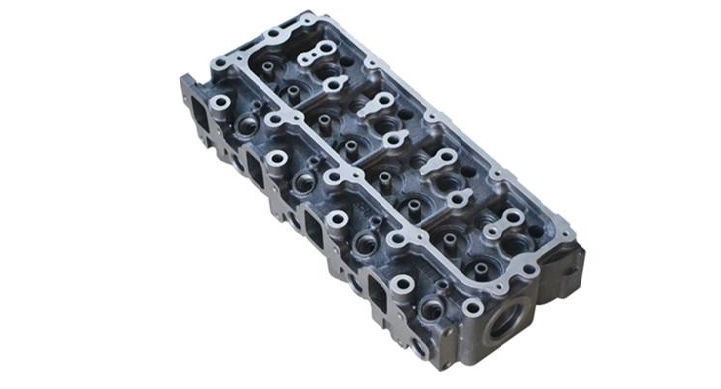We know how frustrating it can be when your cylinder head cracks. You're losing coolant, have compression in your cooling system, or seeing excessive smoke, and you're looking at lost time and money and an expensive repair.

One of the keys to saving yourself this frustration is trying to prevent cylinder head failure before it happens.
In this post, we're taking you through why your cylinder head may be cracked and how you can help prevent it in the future. We're here to help you get back up and running, fast, and prevent a repeat failure.
WHAT CAUSED A CRACK IN MY CYLINDER HEAD?
In a failed cylinder head, the most common symptom people see is a cracked head.
If your head is cracked, you're probably wondering what caused it. Traditionally, a cracked cylinder head is a result of temperature and pressure.
In other words, extreme temperatures and pressure inside the cylinder produce an environment that the cylinder head can't withstand. The material will begin to weaken over time and you'll get a crack or multiple cracks in your cylinder head.
YOUR VALVES CAN SUFFER TOO
Your valves suffer in this same environment, they'll likely end up stretching, breaking, or a common failure is a chordal fracture. We've also seen situations where valves “grow”.
This extreme temperature causes the stretch in the valve and reduces the clearance between the valves and rocker arms. You'll see a reduction in overhead lash and accelerated wear.
By putting in stronger or more durable valves like inconel valves you can help solve the valve problem, but it won't necessarily stop the cylinder head from cracking. You'll be treating a symptom rather than the cause of the problem.
If you have liner protrusion problems or a blown head gasket, for example, you'll still end up with a crack in the head. You're not going to get around that unless you fix the base engine problem.
It is very unlikely that a crack in the cylinder head is a result of defective material. There is more likely an underlying issue that needs to be addressed to help the life of your head.
ENGINE DELETIONS CAN CAUSE CYLINDER HEAD ISSUES
If you've changed your emissions status or horsepower, you've probably affected your engine timing, which might be the cause of cracking in your cylinder head.
Engine deletions can create an environment that makes the head more susceptible to cracking, especially with twin turbos. If these engines have been deleted, you're more likely to see cylinder head cracks from the higher compression ratio pistons, timing and fuel air ratios that are now out of balance.
It's important to note that engine deletions are illegal, and we don't participate in or condone the practice. But, if you're running into problems with your cylinder head on a deleted engine, there's a few things to note.
HOW DELETIONS AFFECT YOUR ENGINE
First, people will commonly choose to delete their engines because of problems with the aftertreatment system and poor fuel mileage. And while these problems might be fixed after the deletion, it does create other problems in your engine.
It can inadvertently cause the cracks in your cylinder head because the cylinder pressures are raised. This means the timing is off and the temperatures are hotter.
PREVENTING CYLINDER HEAD CRACKS
We don't handle the calibrations with the timing on deleted engines, but there are some things you can do to help prevent your cylinder head from cracking.
First, you can reduce the cylinder pressure and temperature. There are multiple ways to accomplish this, but if you want to stop the head cracks and gasket leaks this needs to be done.
It's also become common, on 3406's and C15's, to change the horsepower calibrations on them to try and get all the horsepower out of them as possible. Sometimes, though, not everything works together and you might start to see issues.
OTHER ISSUES THAT CAN CAUSE CYLINDER HEADS TO OVERHEAT
You might be having issues because the counterbores weren't cut, the liner protrusion is off, and you blow a head gasket. This causes compression in the cooling system resulting in air pockets, which overheat the cylinder head.
Driving conditions can also cause cracks in your cylinder head. If you're driving through mountainous areas, you have long pulls that put the engine under a duty cycle for a longer period of time.
This can be counteracted by the driver, how they shift, and what RPM ranges they run, keeping boost a little lower and RPMs a bit higher. Just because you don’t have to shift to crest a hill doesn't mean you shouldn’t downshift.
Many drivers have the desire to not downshift as they go over a hill. This will bring the engine RPMs down and result in higher engine temperatures.
The faster the piston spins, the more air comes in the engine, and the more exhaust and heat goes out. Faster RPMs mean you're getting more exhaust out of the engine, which lowers the temperature. This will help your cylinder head last longer.
One unique thing about diagnosing cylinder head issues is that you can't really measure the cylinder pressure and temperature. Unlike your oil pressure, there isn't a gauge that tells you what your cylinder pressure is.
So, it's really a hidden enemy, causing problems every day. Boost pressure is an indicator, so sometimes less is better!
